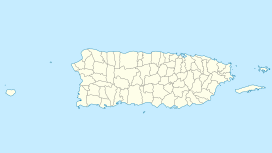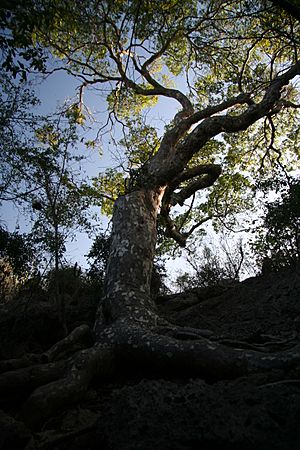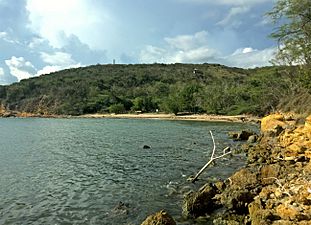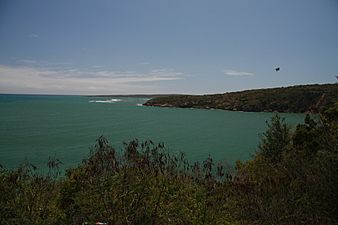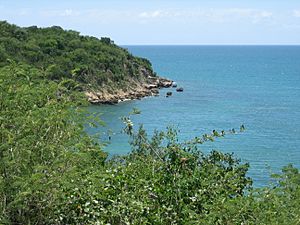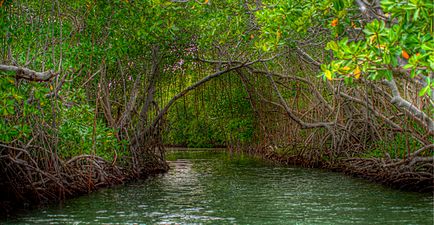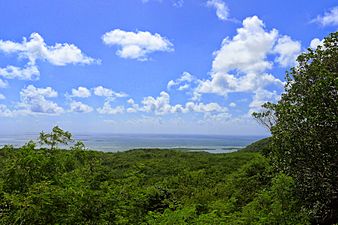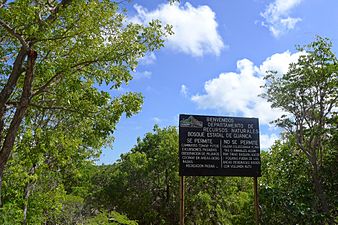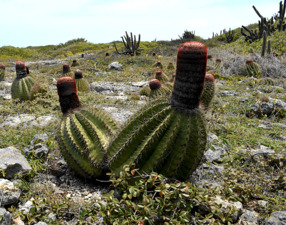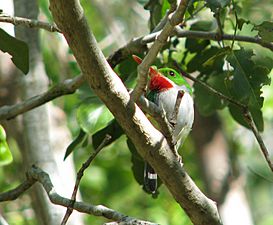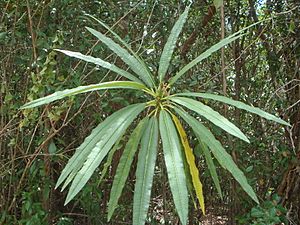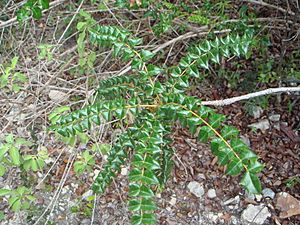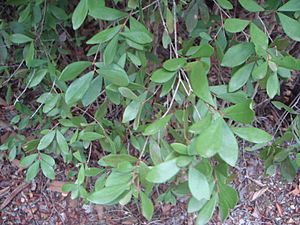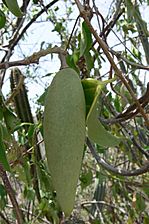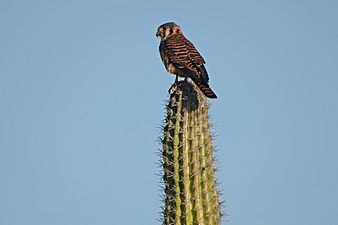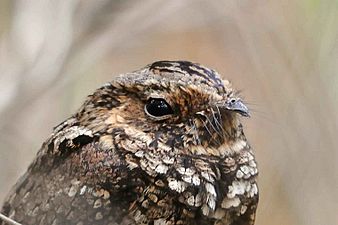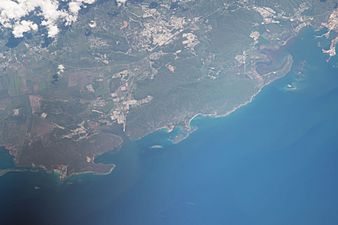Guánica State Forest facts for kids
Quick facts for kids Guánica State ForestSpanish: Bosque Estatal de Guánica Bosque Seco de Guánica |
|
|---|---|

"melón de costa" (Melocactus intortus)
|
|
| Map | |
| Geography | |
| Location | Guánica, Guayanilla, Peñuelas, Ponce, Yauco |
| Coordinates | 17°57′56″N 66°52′45″W / 17.96556°N 66.87917°W |
| Area | 9,878 acres (39.97 km2) |
| Administration | |
| Status | Public, Commonwealth |
| Established | 1919 |
| Governing body | Puerto Rico Department of Natural and Environmental Resources (DRNA) |
| Ecology | |
| WWF Classification | Puerto Rican dry forests |
The Guánica State Forest (Spanish: Bosque Estatal de Guánica), also known as the Guánica Dry Forest, is a special type of forest in southwest Puerto Rico. It's called a "dry forest" because it doesn't get as much rain as other forests. This area was set aside as a forest reserve in 1919. Later, in 1981, the United Nations named it a Biosphere Reserve. This means it's a very important natural area that needs to be protected. Many people believe it's the best example of a dry forest in the entire Caribbean.
This forest is huge, covering about 10,000 acres (about 40 square kilometers). It's the largest of Puerto Rico's 20 state forests. The forest stretches across five towns: Guánica, Guayanilla, Peñuelas, Ponce, and Yauco.
Contents
History of Guánica Dry Forest
The Guánica Dry Forest area was first protected in 1919. It was set up as a forest reserve to keep its unique nature safe. In 1981, the United Nations saw how important this forest was for the environment. They officially named it a Biosphere Reserve. This made it the second Biosphere Reserve in Puerto Rico, after El Yunque National Forest.
The forest got even more protection on October 16, 1985. The Puerto Rico Planning Board made it a nature reserve. This added more rules to help keep the forest and its plants and animals safe.
Geography of the Dry Forest
The Guánica Dry Forest is in the driest part of Puerto Rico. This is because it's in the "rain shadow" of the Cordillera Central mountains. This means the mountains block most of the rain from reaching this area.
Temperatures in the forest are usually around 80°F (27°C) in shady spots. In sunny, open areas, it can get as hot as 100°F (38°C). On average, the temperature is about 77.5°F (25.3°C). The forest gets about 31 inches (791 mm) of rain each year.
Geology and Soils
The dry forest sits on a special type of land called the Southern karst region of Puerto Rico. This area has lots of limestone rock. The soils in the forest are mostly made of limestone and soft lime. Some areas also have sand and clay. Different types of plants grow in these different soils. For example, some plants lose their leaves in dry seasons, while others stay green all year.
Ecology and Wildlife
The Guánica State Forest is incredibly important for nature and science. It's a vital home for many animals and plants. Some of these species are found only in this region. The forest has many different types of environments. These include sandy beaches, rocky shores, mangrove forests, and even underwater areas like seagrass beds and coral reefs. It also has limestone caves, saltwater lagoons, and salt flats.
Animals of the Dry Forest
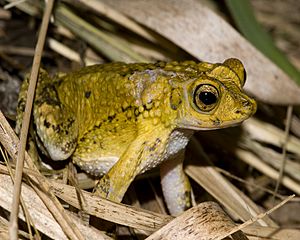
About half of all the bird species in Puerto Rico live in the Guánica State Forest. Nine of the sixteen bird species found only in Puerto Rico also live here.
One very special animal is the Puerto Rican crested toad (Peltophryne lemur). This toad is very rare, and its last natural population lives in this forest. They breed in temporary pools of water that form after seasonal rains. Zoos are working to help these toads. They have breeding programs and release toads into similar areas in Puerto Rico.
Other protected animals in the forest include the Puerto Rican vireo (a type of bird) and the Puerto Rican nightjar (another bird). You can also find the red land crab and the Mona basket shrimp here. The Cook's pallid anole, a type of lizard, also calls this dry forest home. The coral reefs and ocean areas near the forest are full of sea life. This includes the West Indian manatee, which eats seaweed in the underwater meadows.
Plants of the Dry Forest
The plants in the forest are grouped into three main types. There's the deciduous forest, where trees lose their leaves in dry seasons. There's also the semi-evergreen forest, where trees stay green all year. Finally, there's the scrub forest, which has smaller, tougher plants.
There aren't as many different types of trees here compared to other forests. You might find about 30 to 50 tree species in one area. But overall, the forest has more than 700 plant species! Forty-eight of these plants are endangered, and 16 are found only in this forest.
Some of the endangered plants include the sebucan cactus, the palo de rosa, and the violeta tree. The bariaco tree is also critically endangered. One of the most famous plants is a very old guaiacwood tree. It's called the Guayacán Centenario, which means "centenary guaiacwood." This amazing tree could be as old as 1,000 years!
Fun Activities in Guánica Forest
The Guánica Dry Forest is open for visitors to explore. Some of its beaches are very popular with both tourists and local people. You can go fishing and biking in certain areas. Scuba diving is also a popular activity in the coral reefs and off the beaches.
The forest has 12 hiking trails for visitors. They have different difficulty levels, so there's something for everyone. It's also a great place for birdwatching, as so many different bird species live here.
Gallery
-
Salt flats of the dry forest in Boca, Guayanilla.
-
Limestone cliffs in the forest.
-
View of the forest from Carenero, Guánica.
-
American kestrel on cactus.
-
View of the dry forest area, between the Guanica and Guayanilla Bays, from the International Space Station.
See also
 In Spanish: Bosque estatal de Guánica para niños
In Spanish: Bosque estatal de Guánica para niños


